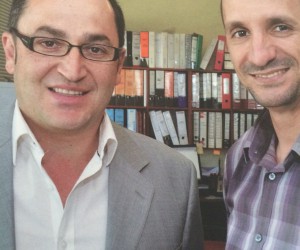DATE: 7 AUGUST
Two SA scientists won the Innovation Prize for Africa by inventing the world’s first injectable regenerating bone graft substitute.
According to the National Osteoporosis Foundation of South Africa (NOFSA), osteoporosis is on the rise in Africa, especially among African women, due to urbanisation and a general lack of awareness, among other factors; figure-conscious females keep an increasingly watchful eye on their weight, impacting negatively on the density of their bones and increasing their risk of contracting bone diseases.
The African Innovation Foundation has named South Africans Dr Nicolaas Duneas and Nuno Peres, from Altis Biologics, as the winners, selected from more than 700 applications from 42 African countries, of the Innovation Prize for Africa (IPA) 2014.
The duo received US$100 000 for the Altis Osteogenic Bone Matrix (Altis OBMTM), the first injectable porcine-derived bone matrix product (BMP) medical device in the world – an innovative product for the treatment of bone injuries and voids through the use of a regenerative biological implant.
Before the Altis OBM was invented, patients with serious bone trauma or degradation would have had to endure the removal of bone tissue from their own hips or from deceased donors – both very invasive methods. The injection of OBM leads to the rapid, safe and effective healing of problematic bone injuries, leading to the complete and natural restoration of the bone, including the bone marrow.
OBM is the only bone graft substitute containing naturally extracted bone growth proteins that co-operate with high efficacy and are sourced from mammals, making it cost-effective to produce.
“This year’s winners showcase that Africans can find solutions to African challenges. We encourage partners from both the public and the private sectors to coherently work together to support African innovation,” says Jean-Claude Bastos de Morais, founder of the African Innovation Foundation and the IPA.
Winners were selected based on the marketability, originality, scalability, social impact and business potential of their innovations. They are provided with unrestricted funds in recognition of their achievements and are free to use the prize to take their innovations to the next level.
The duo told Achiever that this award highlights the high level of innovativeness in South Africa, and stimulates business interest and investment in the process of innovation and commercialisation.
“Aspiring young innovators and university professors are now stimulated to look into possible opportunities within their domains for the innovation process.”
Pires says the competition was fierce, as the IPA isn’t limited to the private sector but also includes applications for universities and research councils.
Duneas, who discovered the concept of synergy among growth factors during his PhD work, then following the initial success for the novel high-yield purification of bone morphogenetic protein-complex from human donor bone in the period 1999–2002, founded Altis Biologics and raised the capital to develop Altis OBM from source material that was available in abundance, namely porcine bone.
“The initial idea arose in 1999 when I initiated a privately funded project to develop human-derived bone growth factors from human donor. In this period, we designed and tested a new process for the high-yield purification of bone morphogenetic protein-complex, and it worked.
“Human donor tissue is very scarce and the human tissue industry is also a not-for-profit industry. So Altis licensed the use of its technology to a human tissue bank that we helped set up in collaboration with a SA university and not-for-profit human allograft distributor.
It was therefore economically unfeasible to pursue a business that relied on human donor tissue, but then I partnered with Nuno and a business plan was created to develop a porcine derived product containing bone morphogenetic protein-complex. After many years of trials, Altis OBMTM was created,” Duneas says.
“Most universities in SA have antiquated policies for commercialising their research, and lack official structures to co-operate with their star scientists. This leads to a lack of interest, motivation and drive for the scientists’ innovations, leading ultimately to failure.
“There isn’t a single venture capital (VC) fund in SA that provides funding for early-stage biotech innovation. The closest that SA has to a private VC fund is the Industrial Development Corporation fund, and even they tread lightly when it comes to the biotech sector. That means bio-entrepreneurs are only left with government as a source of funds.
Fortunately, Government does have some funding available for innovative projects. Unfortunately, the time for a funding decision to be made, the quantum of funding available, and the often complicated and ever-changing policies of these government funds make walking this path a very daunting one for experienced bio-entrepreneurs,” says Pires.
Pauline Mujawamariya






